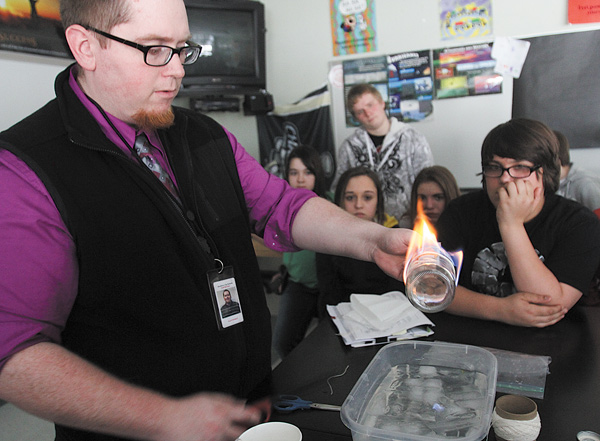Struthers City Schools to intensify STEM-based curriculum


Scott Stoddart, a seventh-grade science teacher at Struthers Middle School, performs an experiment meant to illustrate why elements behave the way they do. Beginning this fall, Struthers schools will incorporate science, technology, engineering and mathematics into all levels of education.
By EMMALEE C. TORISK
STRUTHERS
In Scott Stoddart’s seventh-grade science classroom, each new day means a new challenge for students, a new goal he’s hopeful they will reach by the end of the class period.
But during fifth period Monday, in the midst of an experiment meant to illustrate why elements behave the way they do, Stoddart found himself on the other side of his teaching philosophy. Despite his best attempts, the glass bottle wrapped around the middle with nail polish remover-soaked string, lit on fire and dunked into a vat of icy water, refused to break in half as it had during previous class periods.
Stoddart embraced the experiment’s failure as a teachable moment.
“You hear all the time about items that work, that are successful,” said Stoddart, addressing his class of 25. “What you don’t hear about are how many times it didn’t work. It is a lot of trial and error, a lot of problem solving.”
The type of problem-based learning that Stoddart emphasizes in his science classroom — in which the teacher functions more as a guide than as an authority, and where students often work together in groups — will by this fall become an essential component of curricula across the district.
No longer will science, technology, engineering and mathematics be limited to those individual courses; instead, “everything we do,” from language arts to social studies, will be infused with STEM, said Joseph Nohra, superintendent of Struthers schools.
“It’s not just teaching science and math,” he said. “It starts with students coming up with problems and ways to solve them.”
Nohra said this infusion of STEM into the district’s classrooms has happened slowly over the past few years, but that it continually has increased every year. So, when he took the helm of the district in early 2013, he made it a priority to more aggressively move forward and to incorporate intensive STEM education into all levels at Struthers.
“Building STEM-based curriculum and building STEM-based careers is a matter of national security,” Nohra said. “We don’t have enough folks entering these professions.”
In the coming academic year and beyond, all students at Struthers Elementary School, from kindergarten through the fourth grade, will get a “taste of science and math” every day through a variety of STEM-focused special assignments and hands-on activities.
All fifth- and sixth-graders, then, will take a nine-week-long STEM course that will be alternated throughout the year with other specialized classes, such as physical education and art.
And sometime in the next couple of years, students in the seventh and eighth grades will have the opportunity to participate in a self-contained STEM classroom in which STEM immersion would happen all day, every day for the entire school year.
Finally, Struthers is working with other school districts — Austintown, Canfield and Poland — and the Mahoning County Educational Service Center to create a collaborative STEM-designated school that would house ninth- and 10-graders. Students enrolled there would retain their home schools, said Ron Iarussi, superintendent of the MCESC, and would “hopefully develop a better understanding of what [STEM] careers they want to become involved in.” A location for the school hasn’t yet been identified, he added.
Pete Pirone, principal of Struthers Middle School, said though schools previously hadn’t emphasized STEM to the extent they now do, such exposure is necessary to ready students “for the next generation of jobs.”
Stoddart said it’s critical for problem solving to move beyond the ability to answer a question on a piece of paper and shift toward addressing real-life scenarios — something that often frustrates his students.
But Emily Evinsky, 13, a student in Stoddart’s class, said she enjoys science and may even consider a career in it. “It’s nice learning about how life works,” she said.
 43
43
